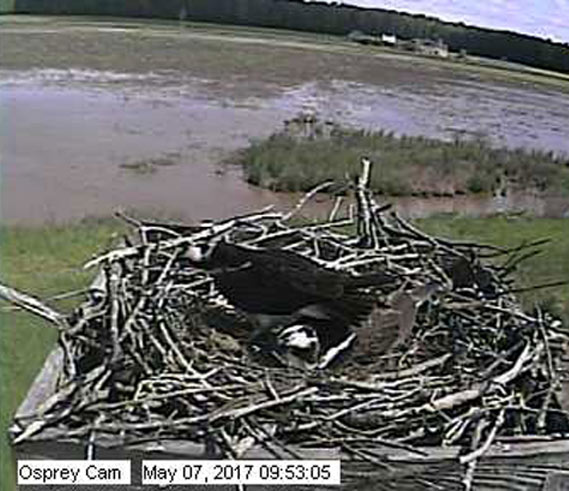Well, we’re in a familiar place it seems. Much like our Eagle Cam nest, it looks like we won’t have chicks at the Osprey Cam nest this season. Our one egg was late in hatching, and then yesterday the egg disappeared, although the parents were still around. Some possible scenarios are that the chick hatched but died immediately or the parents realized the egg was not going to hatch and removed it or buried it. We didn’t see any crows on the nest, so we don’t think they came in to destroy it when it was left unattended.
One cam watcher felt that this year’s female appeared a bit different than last year’s female. If that’s true — that we had a new female — then it’s possible this was her first breeding year and that was the reason she didn’t produce a viable egg (our female last year fledged two chicks). Also, that might explain the one-egg clutch (the expected clutch size is two to three eggs). But whatever the reason, the chick was not viable.
Some folks might wonder if we could see a second clutch. It seems unlikely given that our parents incubated this egg through the entire incubation period (and a bit beyond), so it’s rather late for a second clutch. If they did have an egg that hatched, the chick would have lost an entire month of development time before migration, and it would put the chick at a serious disadvantage come September when the chick would have to migrate alone to South America, so maybe it’s best if they don’t lay any more eggs.
As for the parents, we expect them to hang around the nest for a while because they need to defend it, since it is their home and they want to use it again next year. Eventually we might see less of them on the camera, but they might still be in the area, keeping an eye on the nest to be sure another osprey couple doesn’t try to claim it (for next year). Normally the female osprey would migrate in August and the male would stay to help out the chicks, but since they don’t have chicks, I think both parents might start migrating south in August. Without any chicks to feed and protect, they could both get an early start on migration and possibly miss any hurricanes down south.
We plan to leave the cam on throughout the summer, just to see what kinds of birds show up at the nest and to see what our parents do. Thanks to those who were keeping an eye on the nest and the egg. If you plan to visit Blackwater National Wildlife Refuge during the summer, just a note that we do have chicks at some of the other nests along our Wildlife Drive, which you can drive, walk, or cycle. Below is a photo that Beverly Middleton (one of our volunteers) just took of a two-chick nest along the Drive.
So although our Osprey Cam nest was not successful, other nests at the Refuge will likely be fledging chicks later this summer and you can come and photograph them from the Drive. You can also visit the National Wildlife Refuge System website to find other refuges near you that might be hosting osprey families this summer. And if you’re interested in volunteering at a national wildlife refuge, consider joining a local Friends refuge group.
In addition to keeping the cam up, we’ll also keep the gallery open, if you want to submit photos of any interesting sights. Thanks again for joining us for another osprey season at Blackwater National Wildlife Refuge!
Until next season,
Lisa – webmaster
Support the Blackwater Cams
Contact Us










